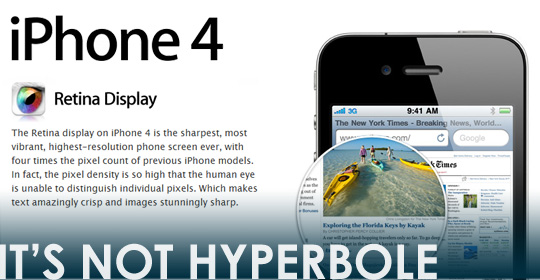iPhone 4 Retina Display – pixel density does matter
At the WWDC keynote on Monday one of new iPhone 4 features that Apple focused on was the 960×640 Retina display, claimed to be the “highest-resolution phone screen ever”. While I initially dismissed its worth as typical Apple hyperbole, an interesting article on tested.com has made me think otherwise
Computer screens aren’t getting any bigger — in fact, they’ve only continued to shrink. While larger displays continue to dominate the upper end of the spectrum, an increasing number of manufacturers are producing netbooks and tablets more suitable for Middle Earth than daily desktop usage. But when it comes to our eyes, these new, minuscule screens aren’t as bad as you think.
While physical sizes may be shrinking, the resolution of these displays is most definitely not. Where a 17″ screen may have once displayed just 1440×900 pixels, those same screens are being built today to handle 1920×1080 resolutions or higher. How, then, do those all-important resolutions keep on increasing?
As an Android user I am now officially jealous of the iPhone 4’s screen. Hopefully it won’t be too long before screens with this pixel density come to other phones too.
You can continue reading the tested.com article here, and their follow-up article on the iPhone 4 screen specifically here.




[…] This post was mentioned on Twitter by Doug Groves, rgbFilter. rgbFilter said: iPhone 4 Retina Display – pixel density does matter: At the WWDC keynote on Monday one of new iPhone 4 features th… http://bit.ly/cpyDcY […]
Though higher pixel density is always better, as they point out, the issue of perception isn’t really addressed. Discerning discreet pixels on a device is not only dependent on density, but normal viewing distance.
I would prefer a device with a physically larger screen with the same pixel count, because it can be read from farther away. For example, a high resolution image, say a scan of a book page that fills the screen edge to edge, will be legible from farther away on an HTC EVO, because of the physically larger screen. The same text in a physically smaller screen, even with a higher pixel count, will need to be held closer to your face.
I’ll take a device that puts more phyiscal screen real estate in front of my face over a higher pixel count any day. Of course, this doesn’t take away from the fact that to increase the screen resolution, it makes sense for Apple to go with 960×480, because it’s a simple doubling of width and height of the current generation iPhones, meaning simple scaling algorithms. Now, if they had made that screen physically larger, all the better, but they shrunk it by a mm or two, because making it bigger could hurt their iPad sales.